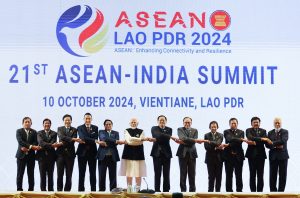Prime Minister Narendra Modi’s visit to Laos last week for the 21st India-ASEAN Summit marked a milestone as it came a decade since India reworked its “Look East” policy to the current “Act East” one.
In his speech at the Laos summit, Modi stressed solidarity with ASEAN as “neighbors, partners in the Global South, and a rapidly growing region in the world.”
India began its engagement with ASEAN in the early 1990s when it re-oriented its foreign and economic policies after the collapse of the Soviet Union. The Indian government decided to forge closer ties with Southeast Asia given that some of the fastest growing economies at the time were in this region. While Singapore, Taiwan, Hong Kong, and South Korea were known as the “Asian Tigers” for their high growth rates, Indonesia, Malaysia, the Philippines, and Thailand were dubbed “tiger cubs” for their economic potential.
It was in 2014, after Modi took office as prime minister, that India transformed its policy toward ASEAN from “Look East” to “Act East,” with the latter referencing India’s increased strategic focus on the region.
At the close of a decade of the “Act East” policy, India-ASEAN ties have been upgraded to a comprehensive strategic partnership. Trade with the region has doubled to over $130 billion. There is air connectivity between India and seven of the 10 ASEAN countries and the Indian Navy regularly makes port calls across the ASEAN region.
Earlier this year, India delivered the first batch of BrahMos supersonic cruise missiles to the Philippines under a deal signed in 2022 — the first time India has exported the BrahMos, which it co-produced with Russia. Two more batches of the shore-based, anti-ship variant of the BrahMos are to be delivered soon.
So, what next for the India-ASEAN partnership?
Modi’s speech at the India-ASEAN Summit and the joint statement issued at the end of it offer some clues. They unmistakably position and underline India as a reliable, steadfast friend and potential defense partner of the ASEAN, with new areas of cooperation identified.
And these come against the backdrop of reports of a pushback by ASEAN against increasing Chinese aggression toward some member countries.
China is a key economic partner of ASEAN. Its trade with ASEAN is worth $1 trillion, making it the regional grouping’s largest trade partner in 2023, for the fourth year in a row. In comparison, U.S. trade with ASEAN was just $500 billion that year.
Despite the outsize trade account with China, ASEAN countries are looking for partners to counter its belligerence on the diplomatic and military fronts. And they see India as a good hedging bet.
The ASEAN Leaders’ Declaration spoke of the “importance of upholding international law, including the Charter of the United Nations and the 1982 United Nations Convention on the Law of the Sea (UNCLOS)” – one of three references to UNCLOS in the declaration. The allusion was to tensions caused by China, which has disregarded a verdict by an arbitral tribunal under UNCLOS that ruled in favor of the Philippines’ claims in the South China Sea.
News reports say the Philippines urged ASEAN leaders at the summit to draw up a much-delayed Code of Conduct for ships and vessels navigating the South China Sea, which China claims almost in its entirety. It’s not only the Philippines; Brunei, Malaysia, and Vietnam also have overlapping claims with China in the area.
In his speech, Modi stressed that India and ASEAN are “peace-loving nations, that respect each other’s national integrity and sovereignty.” The implicit contrast was with an aggressive China triggering tensions with its smaller neighbors.
“I believe that the 21st century is the ‘Asian Century,’ a century for India and ASEAN countries. Today, when there is conflict and tension in many parts of the world, the friendship, coordination, dialogue and cooperation between India and ASEAN are of utmost importance,” Modi said in his opening remarks at the India-ASEAN summit.
The subtext was unmistakably that the “Asian Century” was not to be taken as China’s alone. China looks to dominate Asia in its quest to achieve parity with the United States or even to surpass the U.S. as the dominant world power.
The India-ASEAN joint statement recognized “ASEAN’s rising global relevance and unique convening power amid the emerging multipolar global architecture” and noted “the growing and active role of India in major international economic and political affairs.”
It backed ASEAN’s demands for “maintaining and promoting peace, stability, maritime safety and security” as well as the promotion of freedom of navigation and overflight in the region, and other lawful uses of the seas in accordance with UNCLOS provisions. It also endorsed ASEAN’s concerns over swiftly concluding a Code of Conduct in the South China Sea, in keeping with UNCLOS provisions.
Significantly, the statement also called for strengthening cooperation between India and ASEAN in maritime security, counterterrorism, cybersecurity, and the defense industry. This, it said, will be achieved through joint military exercises, maritime exercises, and port calls by naval ships.
A review of the ASEAN-India Trade in Goods Agreement will be expedited to make “more effective, user-friendly, simple, and trade-facilitative for businesses and relevant to the current global trading practices,” the statement said.
A separate statement on “Advancing Digital Transformation” underscored the potential of fintech to propel the bilateral economic partnership to newer heights. India has offered to share its knowledge and experience in “the development, implementation, and governance of DPI (Digital Public Infrastructure).” Cooperation in the area of artificial intelligence is another area of collaboration
An increase in scholarships for students from ASEAN countries to study at India’s Nalanda University, commemorating 2025 as ASEAN-India Year of Tourism, and other measures to broaden people-to-people linkages round off India’s plans to cement a closer partnership with ASEAN at the start of the second decade of its “Act East” policy.

































